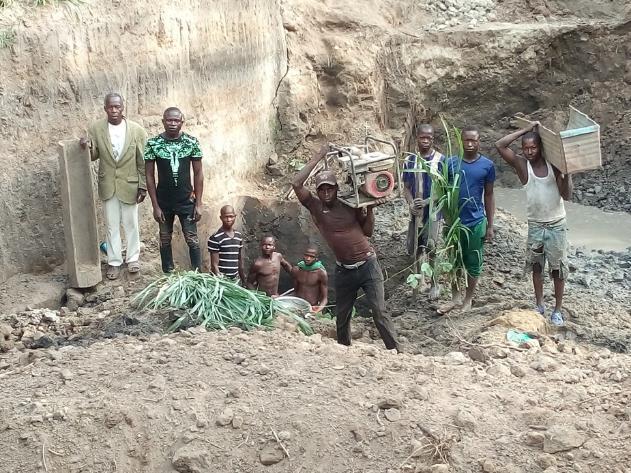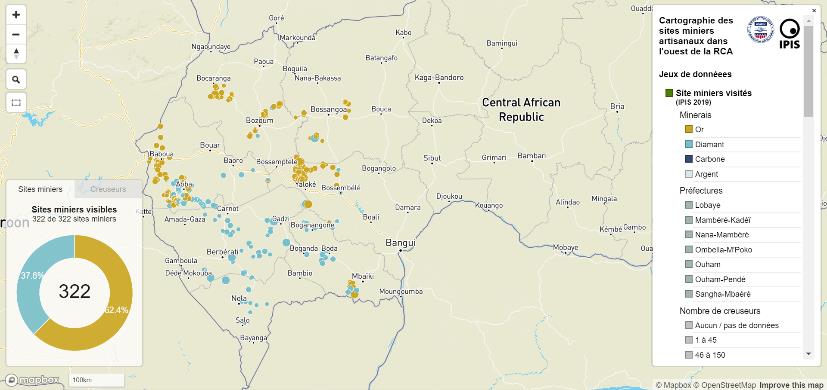Background
The United States Agency for International Development (USAID) Artisanal Mining and Property Rights (AMPR) project addresses land and resource governance challenges in the artisanal and smallscale mining (ASM) sector, using a multidisciplinary approach and incorporating appropriate and applicable evidence and tools. AMPR began in 2018 and is implemented primarily in the Central African Republic (CAR) for an initial period of three years. While the project focuses on the Kimberley Process and diamond governance, Component 3 includes activities aimed at better understanding the growing artisanal gold sector in the country. This brief summarizes key findings from research carried out in 2019, including a mapping and field survey of artisanal gold mining sites in western CAR conducted in collaboration with International Peace Information Service (IPIS). The IPIS study covered 322 sites, of which 201 were gold sites and 60 mined both gold and diamonds. In addition, the brief draws upon other sources, including an assessment by the non-governmental organization (NGO) RESOLVE on options for responsible sourcing in CAR’s gold supply chain, a study on minerals smuggling conducted by AMPR and the Government of CAR in March 2019, and the annual report on the gold and diamond sector prepared by the CAR Ministry of Mines and Geology.
Gold Production Levels and Methods
Artisanal and small-scale gold mining (ASGM) occurs throughout CAR in 10 of 14 provinces. While it overlaps with many diamondiferous areas, ASGM is more widespread. Due to AMPR’s scope and security considerations, the research only focused on western CAR, where armed group activity is less prevalent than in the country’s central and eastern regions. IPIS estimated that the research covered around 30% of CAR’s active mine sites.

The average estimated weekly production at the 261 visited sites that produce gold was 35.7 kilograms. Based on previous research by the U.S. Geological Survey and United Nations Development Programme (UNDP)-UNICEF in 2018, IPIS extrapolated to a national level and estimated 5.7 tons of gold produced per year, assuming 717 gold-producing sites in the country. This figure is higher than the approximately 2 tons estimated by the 2018 UNDP-UNICEF study, which covered more sites in the east but did not conduct in-depth production data collection. By comparison, the country officially exported only 142 kilos in 2018, or around 2.5% of the estimated production.
Site characteristics varied widely, with an average of 10 pits or production units per site. Each pit has an average of 43 workers, and each site an average of 193 workers. Only 10% of pits are large (defined as having more than 50 workers). At least two sites had more than 3,000 workers each. These large sites skew the average number of workers; most sites have 77 workers or fewer, and most pits had 25 workers or fewer. Sites are located both in and along active rivers, as well as terrace deposits and underground mining targeting gold veins. Mining is mostly non-mechanized, with only 6.5% of sites using metal detectors and 1.5% of sites using hammer mills or other mechanized mineral extraction or processing equipment.

The number of people directly working in the visited gold mines was estimated at 45,000, around one-third of whom were women. However, women were present at 83% of sites visited. Extrapolating nationally, IPIS estimated that there are between 150,000 and 200,000 people working directly in the ASM (including diamonds) work force, fewer than the approximately 300,000 people estimated by UNDP-UNICEF in 2018. IPIS estimated that the average weekly earnings per worker were between $9.45 and $11.77,1 not taking into consideration food allowances and other forms of pre-financing. As part of its sub-contract with AMPR, IPIS designed an interactive web map2 that visualizes and compiles all data from the field research, including pictures of each site.

